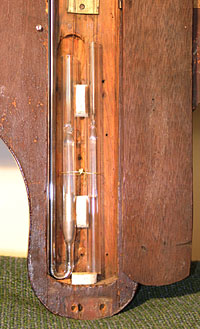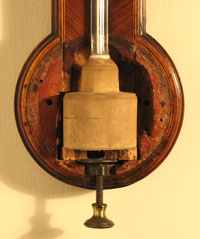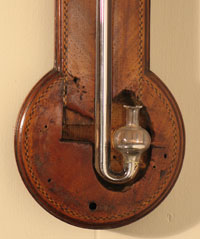
In recent years public health legislation has been enacted in several states that prohibits the sale of any "manufactured item" which contains mercury. The legislation in most instances specifically names barometers as being among the prohibited items. In some cases, such as Connecticut, Maine and Indiana, antique barometers are exempted or "grandfathered" as allowable under the ban in one manner or another, and we see this as a rational trend. In most others, though, the sale of any barometer with mercury in it is specifically forbidden. For the most recent state-by-state summary - June 2008 - we could locate, follow these links:
A summary of legislation enacted through 2006
A summary of legislation enacted in 2007-2008 legislative sessions.
The purpose of this article:
Many collectors now own one or more antique mercury barometers, or may have planned to one day, and I'd like to present another view of the public health issue so that they can make informed decisions. If you disagree with my conclusions, you have my email address.
In my own defense, I have no intention of dealing in something that harms people and I'll comply with the public health laws wherever I encounter them. So, amateur scientist that I may be, I've scoured the learned material on the Internet for the facts that contribute to my side of the controversy, just like everyone else does.
Who uses mercury, and how much of it?
Mercury is used all over the world for many manufacturing processes and in many manufactured items that the average person comes into contact with every day. (So why aren't we dropping over dead by the thousands from mercury poisoning, one might well ask?) According to the US Government's Environmental Protection Agency website, (latest figures are for 2001) the biggest users in order by quantity of the mercury consumed in the US are wiring devices and switches (largely the auto industry and climate control equipment such as your household thermostat) 42%, measuring and control devices 28%, dental amalgams 14%, electric lighting 9%, and the rest for "other". Mercury use in the US has dropped from 2,225 metric tons in 1980 to 245 metric tons in 2001 and is still dropping. Mercury is an element of which there is a finite amount and it is recovered and recycled aggressively, at least in this country. The quantity that is escaping into the environment, then, should also be dropping as time goes on.
I refurbish the antique barometers we sell and recharge their mercury systems with freshly processed instrument grade elemental mercury. The mercury I buy is shipped to me, specially packed and properly labeled as hazardous, by regular UPS service. Old, contaminated mercury that may have been in the barometers is collected and recycled through a mercury processing company. No mercury is lost or discarded from my shop. There is no federal government restriction on buying mercury. I purchase fresh, triple distilled, instrument grade mercury in 16-pound flasks, and one flask can often last me two years. I'm probably one of the more active of about twenty restorers of barometers in this country, so that should give some context for the comparative consumption level of the antique barometer industry. It's miniscule.
How do people come in contact with mercury?
Harm from mercury is highly dependent on how you come into contact with this element, what form it is in, and the length and concentration of the exposure. Quoting the US Geological Survey's web site on the subject of mercury contamination:
Humans generally uptake mercury in two ways: (1) as methylmercury (CH3Hg+) from fish consumption, or (2) by breathing vaporous mercury (Hg0) emitted from various sources such as metallic mercury, dental amalgams, and ambient air. Our bodies are much more adapted for reducing the potential toxicity effects from vaporous mercury, so health effects from this source are relatively rare.
The exposure to mercury from an antique barometer is the vaporous variety, not the biologically altered methyl mercury that exists in the food chain. Exposure through the food we eat comes mainly from the mercury that leeches out of toxic waste sites and landfills, then travels to the oceans and goes up the aquatic food chain. The biggest single source is seafood, and recent Department of Health warnings to pregnant mothers, among others, reflect this.
I could find no data that quantified the two main types of exposure, though the "relatively rare" quote for health effects from mercury vapor applies. Advances in modern times in the reduction of vaporous mercury from manufacturing, at one time the largest offender, have all but eliminated vaporous mercury as a threat.
How does mercury harm a person?
The media has demonized mercury to the point that it has become feared in the way that poisonous arsenic compounds or corrosive acids are feared. Well, not all the bad press is quite accurate (surprise!). You can hold liquid mercury from a barometer in your hand and it will neither burn your flesh nor ruin your lungs with its vapor, causing you to drop over dead.
The hazards to one's health come in various forms, and of course are more pronounced in children with their smaller body mass. Quoting again from the USGS web site, Fact Sheet 146-000 titled Mercury in the Environment:
The toxic effects of mercury depend on its chemical form and the route of exposure. Methylmercury [CH3Hg] is the most toxic form. It affects the immune system, alters genetic and enzyme systems, and damages the nervous system, including coordination and the senses of touch, taste, and sight. Methylmercury is particularly damaging to developing embryos, which are five to ten times more sensitive than adults. Exposure to methylmercury is usually by ingestion, and it is absorbed more readily and excreted more slowly than other forms of mercury.
Elemental mercury, Hg(0), the form released from broken thermometers, causes tremors, gingivitis, and excitability when vapors are inhaled over a long period of time.
"A long period of time" is months and years of high concentrations of the vapor (not the liquid), not minutes or hours in an open atmosphere. Regarding liquid mercury, the same Fact Sheet goes on to say:
If elemental mercury is ingested, it is absorbed relatively slowly and may pass through the digestive system without causing damage.
The California Poison Control System, on its web site, addresses exposure to liquid, elemental mercury (the type in barometers) with this statement:
Of all the forms of mercury, elemental mercury is the most commonly swallowed form of mercury, usually from a broken thermometer. Fortunately, elemental mercury from a thermometer is not absorbed from the stomach and will not cause any poisoning in a healthy person. In a healthy person, the slippery swallowed mercury will roll into the stomach, out in to the bowels and will be quickly eliminated without causing any symptoms. Handling liquid mercury for a very short period of time usually does not result in any problems. An allergic rash is possible, though. Mercury is not well absorbed across the skin so skin contact is not likely to cause mercury poisoning, especially with a brief one-time exposure. Even if a person has cuts in their skin, mercury is too heavy to be contained by a cut. Merely washing the wound well will wash the mercury out of the wound.
Now, I don't mean to let liquid mercury off the hook just because there is a more harmful form out there, but I do want to put the relative threats into context. The level of danger from handling liquid mercury, or being exposed to its vapor, is actually quite low, and EPA and OSHA controls over manufacturing and disposal have dramatically reduced the risk from "prolonged exposure" to mercury vapor in our time to the point that it is, and I quote again, "relatively rare." Antique barometers contain liquid, elemental mercury and are in the vapor emitting class of sources. Read on, if I haven't lost you by now.
How much mercury vapor does an antique barometer emit?
First of all, some of them emit
none at all. Some types of stick  barometers have sealed
mercury systems and therefore there's no evaporation of their contents.
All banjo (or "dial", or "wheel") barometers and
some stick barometers have mercury systems that are
open to the atmosphere, with a very few square millimeters of exposed
surface, so they
are sources of small amounts of vapor.
barometers have sealed
mercury systems and therefore there's no evaporation of their contents.
All banjo (or "dial", or "wheel") barometers and
some stick barometers have mercury systems that are
open to the atmosphere, with a very few square millimeters of exposed
surface, so they
are sources of small amounts of vapor.


Left to right: Stick barometer with
a closed mercury system (boxwood cistern with closing screw);
stick barometer with an open mercury system (bulb cistern) ;
banjo/wheel/dial barometer with an open mercury system (j-tube).
How much is a small amount?
Quoting yet again, this time from the
OSHA web site:
(http://www.osha.gov/SLTC/healthguidelines/mercuryvapor/recognition.html)
The current Occupational Safety and Health Administration (OSHA) permissible exposure limit (PEL) for mercury vapor is 0.1 milligram per cubic meter (mg/m(3)) of air as a ceiling limit. A worker's exposure to mercury vapor shall at no time exceed this ceiling level.
OSHA specifies no time limit for this exposure (TWA as it is often referred to, Time Weighted Average). However, in this same body of information, The National Institute for Occupational Safety and Health (NIOSH), using a 1992 standard that has since been lowered (can't find out what it has been lowered to), has established a recommended exposure limit (REL) for mercury vapor of 0.05 mg/m(3) as a TWA for up to a 10-hour workday and a 40-hour workweek.
So, using the NIOSH standard, which is the most stringent, you as an adult human can be steadily but safely exposed to a 0.05 milligram of mercury vapor per cubic meter of atmosphere for up to 40 hours per week. A fifteen by fifteen foot room with an eight-foot ceiling (1800 cubic feet, about 51 cubic meters) would be allowed a total input of 2.55 milligrams of mercury vapor over 40 hours. For our computation, we'll ignore the obvious assumption that you aren't going to spend 40 hours per week in the same room with your barometer, but we'll extend the Time part of the equation to the seven days you'll be in your home, 70 hours altogether, or 4.46 milligrams of mercury vapor.
No home is airtight, or we would all die of oxygen deprivation while indoors. The average home, and our hypothetical room is going to flush and renew its air supply through leaks, open doors and windows, HVAC systems, etc. several times per day. Let's call it three times per day, probably a pretty low frequency.
At the maximum allowable exposure of 4.46 mg of vapor for seven days, flushed by fresh air 21 times, the source of the mercury vapor, an antique barometer in this case, would have to emit a total of 93.66 mg of mercury vapor per week to hit the NIOSH minimum allowable exposure.
I know that I can fill three banjo or open-cistern stick barometers' mercury systems with one pound of mercury, so each instrument contains about 5.5 ounces (156 grams). I have a banjo barometer on the wall at home that I last serviced about fifteen years ago, and in those 15 years there have been 780 weeks of exposure (52 of those 7-day weeks times 15 years = 780 weeks). That makes 73.06 grams of mercury (93.66 milligrams X 780 weeks = 73,055 milligrams = 73.06 grams, or 46.8% of the total volume) that would have had to evaporate from my barometer to reach OSHA's minimum allowable safety levels. In the 15 years I've had it on the wall, it would have had to lose nearly half of its mercury to be a threat to me.
That barometer has lost no mercury, or at least not enough to measure visually, and 50% or even 10% or 5% would be immediately very obvious. I'm willing to bet that the same is true for any other antique barometer that has hung in one place for so long.
What's the conclusion?
A mercury barometer in the home is no threat to your health. A collection of 25 barometers, all in the same room and all with open systems, might approach the lower limits of NIOSH or OSHA exposure limitations, but as I said, who sits in the same airtight room all day every day for seven days per week? OK, someone probably does.
The mercury vapor emitted by a household barometer is too low by itself to be of any threat to either you or your infant children. But, if you lived on a toxic waste site and ate swordfish three meals per day, the accumulated effect of that could be a problem. That's what most of the health and safety legislation is aimed at, the accumulated effect of so many products and processes that have released mercury into our environment in the past.
So how much mercury escapes from broken antique barometers into the environment? I have no way of estimating it but I don't see it as a very significant threat. I doubt that many people are heaving $5,000 barometers into the ocean. Feel free to disagree.
If you do have an accidental spill of mercury, however, go to this web address for authoritative, non-scare tactics on dealing with it. Be assured you don't have to destroy your house or call in the men in white suits. EPA will tell you that, the white suits won't.
http://www.epa.gov/mercury/disposal.htm
Finally, the end.
I think I've put forward a decent argument that one has nothing to fear from owning an antique barometer that's in full working order, but I'm not naïve enough to believe that it's going to change any of the legislation. Collectors and sellers of fine antique barometers are both going to pay a big price for the abuses of the industrialized world, but probably no more than our share. Tough, but that's just the way it is. It is also quite possible that collectors will still buy barometers that don't have mercury in them, or we'll find a substitute material. Hope so. I've got some good ones, and Virginia hasn't banned them. Yet.
Charles Probst, 17 June 2008